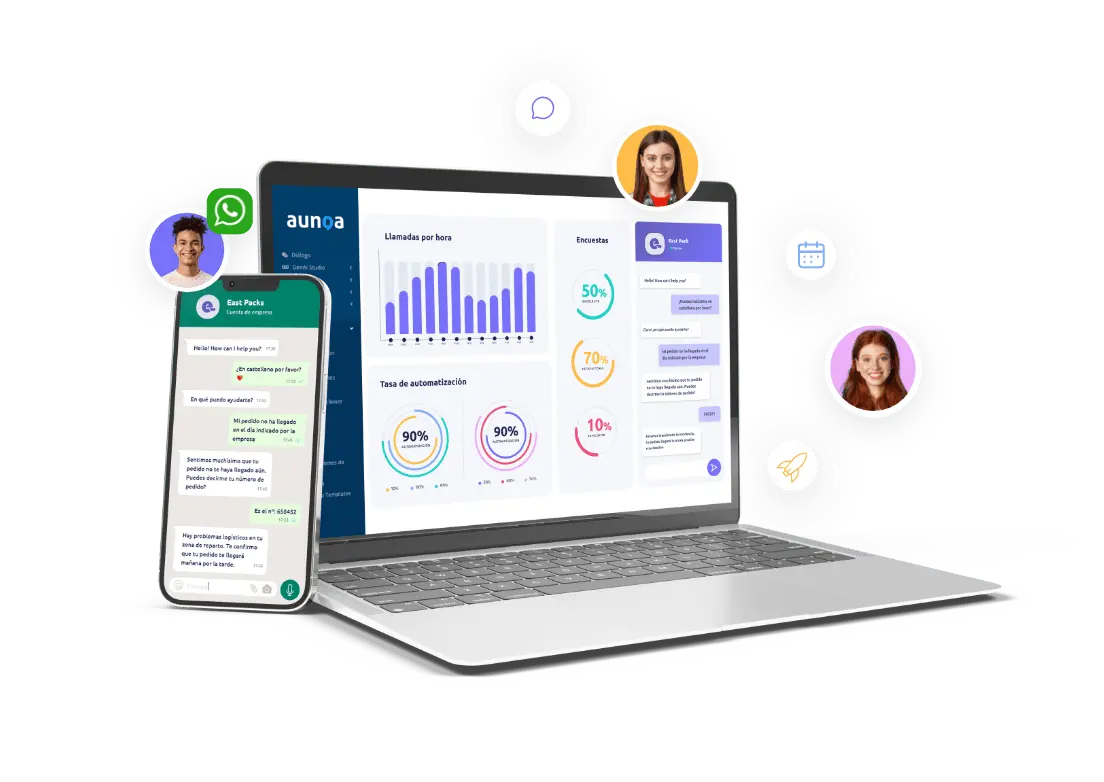You might be thinking about implementing an AI-powered chatbot in your business, or maybe you’ve already incorporated it into all your online platforms. Regardless of your situation, it’s crucial to understand the key metrics to track and measure its performance to ensure its successful application.
What is a performance metric?
A metric is a quantifiable measure used to evaluate the status and scope of a specific action. Defining these metrics is essential in any business process, including, in this case, the installation of a chatbot.
In previous blog posts, we’ve explained what a chatbot is, how it works, and why you should use it in your business. In short, implementing a chatbot allows you to automate conversations with your customers or potential customers, enhance their user experience, and make your business more efficient.
However, analyzing and tracking a chatbot’s performance goes beyond that—it gives you deeper insights into the users it interacts with. At Aunoa, we bring you 7 key metrics to assess the efficiency of your chatbot in your business.
Metric 1: Automation rate
Are you aiming to position your chatbot as the main point of contact? To determine if you’re achieving the goal of automatically assisted inquiries, you’ll need to quantify how many interactions are handled by a person versus how many are managed by your virtual assistant.
This metric is essential for identifying the threshold that will help you reach the strategic business objective you’ve set.
At Aunoa, we’ve enabled our clients to achieve up to a 90% automation rate in resolving frequent inquiries (FAQs), 60% in managing transactional queries like order tracking or data updates, and 75% automation in procedures such as service sign-ups or reservation modifications through the implementation of intelligent chatbots for businesses.
Metric 2: Average conversation duration
The average session duration reveals the interaction time between the user and the company.
This is a challenging metric to measure because a long conversation might be linked to a complex query, involving different questions and answers, and sometimes requiring escalation to a human agent. Simpler conversations are usually related to frequent inquiries or straightforward questions, such as order tracking and stock queries.
Conversation duration also depends on the chatbot’s functionality: whether it has guided flows or menus, or the number of questions it resolves in a single conversation. Depending on your business type, you should identify the ideal average conversation length by analyzing conversation history and discovering your customers’ preferences.
For example, in the insurance sector, inquiries are often complex and require significant personalization. However, in the Utilities or Telco industries, FAQs can be easily resolved in a matter of minutes.
In connection with this indicator, immediacy—a factor increasingly valued and, therefore, crucial for conversion—plays a key role. This means that if the chatbot offers direct and immediate interaction, the likelihood of conversion increases significantly.
To achieve this, it’s advisable to configure the chatbot with key questions organized into categories and guided menus to facilitate user interaction.
In this case, it’s important to track the First Response Time or the overall resolution time. Chatbots will always contribute to lowering this metric due to their immediacy.
Metric 3: Retention rates
This is one of the most important metrics when conducting measurements, especially if you’ve recently implemented a chatbot on your online platforms.
It’s important to differentiate between new and returning users in the total number of users interacting with your virtual assistant. If the number of returning users is stable over time, it’s likely that the first user experience was satisfactory, leading to higher retention—a high percentage of users who return to use the chatbot over a certain period.
This indicator is very positive not only because it shows that your Virtual Assistant has a high acceptance rate, but also because it allows you to gather more data about the same user. This information is crucial for continuously improving its configuration and enhancing the experience on this channel.
Metric 4: Abandonment rate
The efficiency of a chatbot is directly proportional to the satisfaction expressed by the user. Therefore, a high abandonment or bounce rate indicates a chatbot session that ends before the problem is solved, or the query is completed. If this indicator is very high, it could be a negative sign, suggesting that your chatbot isn’t functioning correctly.
It’s crucial to analyze this metric to determine at what point in the conversation customers abandon the service and why. Extracting this information will guide you in making the necessary adjustments to improve the virtual assistant’s performance.
It’s also important to note that conversations escalated to agents aren’t considered abandonment. This depends on the chatbot’s functionalities and characteristics and is directly related to the target automation threshold.
If the chatbot’s goal is to answer simple customer service questions, this number should always be as low as possible. However, if we’re talking about lead generation, the goal is for the chatbot to filter and escalate all conversations to agents.
Metric 5: Confidence or Accuracy Rate (NLP)
To retain and attract customers, you need to create a user experience so satisfying that the customer has no doubt that the company perfectly understands what they’re looking for.
Therefore, evaluating the comprehension level of an NLP model (the Knowledge Base used by the chatbot to automate conversations) means verifying the chatbot’s ability to identify questions and respond effectively with the most appropriate answers in each case.
This measurement not only helps define the match level between what the user asks and what the chatbot answers but also helps identify improvement points for training these models.
This means it’s a metric that should progressively improve—the more training an NLP model has, the higher the confidence rate and, consequently, the greater the accuracy of the Virtual Assistant’s conversations.
In NLP models, a response with a confidence rate of over 60% is considered accurate. It’s always important for most responses to be given with a rate of over 70%, indicating that the bot has enough expressions and can respond accurately.
Metric 6: Satisfaction Metrics (CSAT)
Tracking the overall performance of a customer service channel involves evaluating the customer experience provided. One way to measure this performance is by using Customer Satisfaction metrics (CSAT or NPS), whose score indicates how satisfied customers are with the experience.
When it comes to measuring a chatbot’s CSAT, this indicator is extremely useful because it helps you understand whether the user was well assisted by the chatbot and, therefore, whether they achieved what they were looking for.
To gather this information, you can launch satisfaction surveys at the end of a conversation, where your users rate their experience with the virtual assistant on a scale of 1 to 5.
An ideal CSAT metric should be above 70%, but it’s important to measure the CSAT for each channel.
Metric 7: Conversation volume by channels
The number of unique users and the number of conversations depend on the volume of inquiries a business receives and its business model, but it’s essential to measure it to understand chatbot traffic and the conversation volume across channels.
Understanding the conversation volume by each customer service channel means identifying customers’ preferences when choosing one platform over another (website, Facebook, or even WhatsApp) to make inquiries or requests.
This way, you can identify which channels need to be prioritized to ensure your chatbot is available on all the channels that customers most frequently use to communicate.
Intelligent chatbots to maximize your metrics
These are some key metrics to assess the efficiency of your chatbot.
At Aunoa, we specialize in implementing multichannel chatbots to enhance your customer service in terms of user experience and inquiry resolution.
Save operational costs and boost your digital communication channels.
Request a demo and see for yourself what our platform can do!






